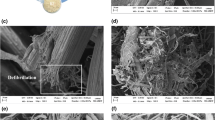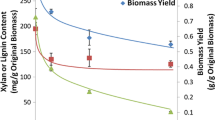Abstract
Cellulose powder and softwood sawdust were subjected to alkaline degradation under conditions representative of a cementitious environment for periods of 7 and 3 years, respectively. During the first 3 years, sampling was frequent, and data on the degradation of cellulose and production of isosaccharinic acid was used for establishing long-term prediction models. Samples after an additional period of 4 years were compared to the predicted values. The total rate of degradation was measured as the increase in total organic carbon (TOC) in corresponding solutions. A previously published theoretical model of degradation kinetics gave a good approximation of the present experimental data. Peeling-off, stopping, and alkaline hydrolysis reaction rate constants were obtained as model parameters, and the results suggested that the transformation of the glucose end group is the rate-limiting step in the cellulose peeling-off reaction and also determines the pH dependence of that reaction. After 3 years, isosaccharinic (ISA) acid represented 70–85% of all degradation products as quantified by capillary zone electrophoresis. The long-term prediction model indicated that all of the cellulose would be degraded after only 150–550 years. The control sampling after 7 years points toward a lower degradation of cellulose and production of ISA than predicted by the model, reflecting either a degradation of ISA that was faster than the production or a termination of the ISA production.
Similar content being viewed by others
References
A. Blazej and M. Kosík (1985) in J. F. Kennedy, G. O. Phillips, D. J. Wedlock, and P. A. Williams (Eds.), Cellulose and its Derivates: Chemistry, Biochemistry and Application, Ellis Horwood Limited, New York, pp. 97.
P. C. Gupta and A. Day (1984) Cellulose Chem. Technol. 18, 79.
O. Theander, (1988) in S. Tipson and D. Horton, (Eds.) Advances in Carbohydrate Chemistry and Biochemistry, Vol. 46, R. Academic Press, San Diego, pp. 273.
K. Niemelä and E. Sjöström (1986) Biomass 11, 215.
G. M. N. Baston, J. A. Berry, K. A. Bond, M. Brownsword, and C. M. Linklater (1992) Radiochim. Acta 58/59, 349.
J. A. Berry, K. A. Bond, D. R. Ferguson, and N. J. Pilkington (1991) Radiochim. Acta 52/53, 201.
M. Wiborgh (1995) Prestudy of Final Disposal of Long-Lived Low and Intermediate Level Waste, TR 95-03V, Swedish Nuclear Fuel and Wste Management Company (SKB), Stockholm.
L. R. Van Loon and M. A. Glaus (1997) J. Environ. Polym. Degrad. 5, 97.
B. F. Greenfield, W. N. Harrison, G. P. Robertson, P. J. Somers, and M. W. Spindler (1993) Mechanistic Studies of the Alkaline Degradation of Cellulose in Cement, NSS/R727, AEA Technology, Harwell, United Kingdom.
X. Bourbon and P. Toulhoat (1996) Radiochim. Acta 74, 315.
M. H. Johansson and O. Samuelson (1978) J. Appl. Polym. Sci. 22, 615.
B. Y. Yang and R. Montgomery (1996) Carbohydr. Res. 280, 27.
Y.-Z. Lai and K. V. Sarkanen (1969) J. Polym. Sci. Part C 28, 15.
I. Ziderman and J. Bel-Ayche (1978) J. Appl. Polym. Sci. 22, 1151.
I. Ziderman and J. Bel-Ayche (1986) J. Appl. Polym. Sci. 32, 3255.
B. Lagerblad and J. Trägårdh (1995) Conceptual Model for Concrete Long Time Degradation in Deep Nuclear Waste Repository, TR 95-21, Swedish Nuclear Fuel and Waste Management Company (SKB), Stockholm.
R. L. Whistler and J. N. Biller (1963) in L. Whistler and J. N. Biller (Eds.), Methods in Carbohydrate Chemistry. Academic Press, San Diego.
P. Jandik and W. R. Jones (1991) J. Chromatogr. 546, 431.
J. Hagberg, J. Dahlén, S. Karlsson, and B. Allard (2000) Intern. J. Environ. Anal. Chem. 78, 385.
D. W. Haas, F. Hrutfiord, and K. V. Sarkanen (1967) J. Appl. Polym. Sci. 11, 587.
SPSS for Windows, version 8.0.0, (1997), SPSS Inc.
I. Ziderman and J. Bel-Ayche (1978) J. Appl. Polym. Sci. 22, 711.
E. R. Garret and J. F. Young (1970) J. Org. Chem. 35, 3502.
J. M. Los and L. B. Simpson (1956) Recl. Trav. Chim. 75, 267.
T. W. G. Solomons (1994) Fundamentals of Organic Chemistry, John Wiley & Sons, New York.
L. R. Van Loon, M. A. Glaus, S. Stallone, and A. Laube (1997) Environ. Sci. Technol. 31, 1243.
Author information
Authors and Affiliations
Corresponding author
Rights and permissions
About this article
Cite this article
Pavasars, I., Hagberg, J., Borén, H. et al. Alkaline Degradation of Cellulose: Mechanisms and Kinetics. Journal of Polymers and the Environment 11, 39–47 (2003). https://doi.org/10.1023/A:1024267704794
Issue Date:
DOI: https://doi.org/10.1023/A:1024267704794




